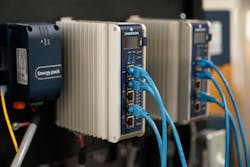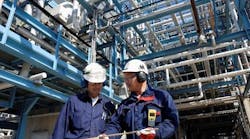Upstream and midstream oil and gas operations employ many types of equipment that can be rich sources of operational and diagnostic data. This data is necessary so operators can optimize production and so maintenance personnel can evaluate asset performance and identify possible problems. However, the geography and remote locations where these sites are typically situated can make it costly and impractical to tap into that data.
Regardless of whether users want to monitor only a handful of points or thousands and whether they are upgrading an existing brownfield location or designing a new greenfield site, it has become mandatory to move beyond basic functionality by adding comprehensive remote connectivity and monitoring features.
For legacy installations, there have been some ways for creatively implementing connectivity throughout widespread systems. However, these methods have been relatively difficult and expensive to design, operate and support. This has now changed due to the availability of a new class of industrial edge controllers. These controllers can supersede the functionality of traditional platforms, while adding advanced processing and communication features. This article describes how edge controllers are a fast and efficient solution for adding or building in remote monitoring and digital transformation capabilities.
Legacy linkages
Much of the oil and gas operational data comes from sensors, equipment and electrical devices used to locally automate the processes. Most of these sources have become progressively more intelligent in recent years.
Instead of providing just a single process variable, some sensors can now transmit data with respect to scores of variables and parameters via a digital communications link. Packaged equipment automation systems may come from vendors with built-in Ethernet communication capabilities. Other devices, such as variable frequency drives (VFDs) and switchgear power monitors, can provide extensive live data and diagnostic information. Collectively, these smarter devices are the main sources of data in the industrial internet of things (IIoT).
Traditional platforms used to connect with hardwired and smart devices include:
- Programmable logic controllers (PLCs): Primarily used for machine and equipment automation but feature some communications.
- Programmable automation controllers (PACs): Similar to PLCs but have improved process control, data handling and communication features.
- Remote terminal units (RTUs): Somewhat like PLCs but have specific remote communication features.
- Human-machine interfaces: Operator interface for providing localized visualization for PLCs, PACs and RTUs.
- Supervisory control and data acquisition (SCADA) systems: A supervisory network of computers often connected to many PLCs and RTUs, providing control room visualization.
- Distributed control system (DCS): A large and integrated process control and visualization system.
Edge controller advantages
Based on modern multicore processors, the most robust edge controllers implement hardware virtualization to deliver two completely independent operating systems (OSs) — each with their own dedicated network and USB ports. The first OS is a real-time operating system (RTOS) to provide reliable deterministic control like a PLC or an RTU. The second OS is a general-purpose OS like Linux, enabling users to execute advanced computing, analytics and data handling. This second OS also features secure and efficient IT-based and firewall-friendly communication options for reliable networking over the types of low-bandwidth connections often found at remote oil and gas sites.
Edge controllers work well for oil and gas digital transformation initiatives because they provide:
- Automation: Perform native automation, but users do not need to use this capability if it is not required.
- OT connectivity: Natively support legacy protocols like PROFINET and Modbus/TCP, as well as newer, more secure protocols like OPC UA.
- Computing flexibility: Carry out data preprocessing, analytics, visualization and other computing tasks right at the edge, without the cost and latency experienced when using higher-level computing resources. Use standard languages like C, C++, Python, Java and more.
- IT connectivity: Natively support secure IT-oriented communications with protocols like MQTT and secure sockets (HTTPS, SSL, FTPS). In particular, MQTT is a lightweight protocol optimized for data transfer over low bandwidth networks with intermittent communications.
Designers will find that these edge controller features help them architect small to medium-sized projects in a simpler manner compared to traditional solutions.
Fit for purpose
Upstream and midstream oil and gas systems include many subsystems, such as:
- Wellheads
- Artificial lift
- Hydraulic fracturing (fracking) equipment
- Gas processing systems such as slug catchers and acid gas removal
- LNG liquefaction (compressor trains, flare stacks)
- Logistics (pipelines, pumping, tanks, boil-off gas compressors, terminals, storage and loading)
Larger multithousand input/output systems, such as an entire compressor train or various related processing units, may be automated by a single DCS. However, these operations often consist of many small to medium-sized subsystems. Each of these subsystems can be automated with an edge controller, which in turn communicates well with the supervisory DCS. This architecture provides modularity and flexibility, while enforcing a level of consistency in the design. It also allows vendors to control the intellectual property involved with their equipment, while enabling a smooth interface with supervisory systems.
Application examples
Several LNG projects have recently been executed or are under way and incorporate an edge control approach for implementing automation and for facilitating remote monitoring over great distances. These and other similar projects provide the following benefits:
- Programming ease: Less labor to integrate and simpler support, reducing project duration so systems can be commissioned sooner.
- Fit for purpose: Users gain advanced edge capabilities at a price point similar to traditional PLCs.
- Modular hardware and software design: Support consistency and reusability, so it is easier to scale up the project or execute similar future projects.
- High availability: Redundancy at the hardware and networking level provide the reliability required for these critical operations.
Edge control helps the oil and gas industries achieve their automation goals while reducing risk and streamlining execution. Built-in IT communication capabilities allow users to natively connect these systems to on-site or cloud-located databases and to visualization and analytical systems. With the right data available anywhere it is needed, users can optimize all aspects of their operations.
Conclusion
There are many reasons for upstream and midstream oil and gas operations to incorporate edge processing. Besides the mandatory need for safe, reliable and optimized control, companies need to access the available data from many types of equipment. This data must be analyzed at the edge, with results sent to the cloud, so users can determine how to best operate and maintain their sites.
Edge controllers are an evolutionary automation platform merging the best aspects of OT and IT computing and network communication. They are suited for the remote environments and limited networking associated with oil and gas sites. Users are finding that edge control is an efficient and economical way to upgrade existing sites, as well as to build out new sites with modern connectivity.Denka Wangdi is a marketing leader for Emerson’s machine automation solutions business and is responsible for its portfolio targeting the oil and gas market. Wangdi has over 15 years of experience in subsea, surface and R&D commercial models.





